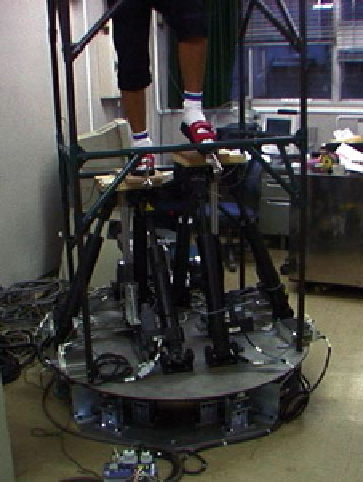Biomedical Engineering Reference
In-Depth Information
Fig. 9.11
Overall view of
GaitMater
Each motion-base is controlled to trace the position of the foot. The turntable is
controlled to trace the orientation of the walker. The motion of the turntable removes
interference between the two motion-bases.
The X and Y motion of the motion-base traces horizontal position of the feet and
cancel its motion by moving to the opposite direction. Rotation around the yaw axis
traces the horizontal orientation of the feet. The Z motion traces vertical position of
the feet and cancels this motion. The rotation around the roll and pitch axis simulates
the inclination of a virtual surface.
Figure
9.11
shows overall view of the prototype GaitMaster. In order to simplify
the mechanism of the motion-platform, the surface of the virtual space was defined
as sets of planar surfaces. Most of buildings or urbane spaces can be simulated
without inclination of the floor. Thus, the roll and pitch axes of the motion-platforms
could be neglected. Each platform of the prototype GaitMaster is composed of three
linear actuators top of which a yaw joint is mounted. A 6 DOF Stewart platform
was disassembled and made into two XYZ stages. Three linear guides are applied
to support the orientation of the top plate of the motion-platform. The payload of
each motion-platform is approximately 150 Kg. A rotational joint around yaw axis
is mounted on each motion platform. The joint is equipped with a spring that moves
the feet to the neutral direction.
A turntable was developed using a large direct-drive (DD) motor. The maximum
angular velocity is 500 deg/s. A three degree-of-freedom goniometer was connected
to each foot. The goniometer measures back-and-forth and up-and-down motion


